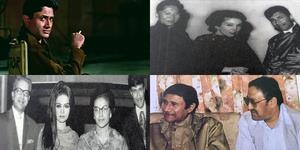
Dev Anand: The Ageless Romantic Who Pioneered Bollywood's 'Neighbourhood First' Initiative
It was in the 1950s that Indian filmmakers set their sights outside and Ashok Kumar-Nalini Jaywant's "Naaz" (1954) was the first to be shot abroad - in Cairo and London. Raj Kapoor's "Sangam" (1964) opened the floodgates and was followed by the likes of "Love in Tokyo" (1966), "An Evening in Paris" - which marked the start of Bollywood's Switzerland tryst, and "Around the World" (both 1967) and many others.
However, Dev Anand, who would have turned 101 on this day (September 26), had his sight on equally picturesque, much closer, yet virtually untapped foreign locales - the Himalayan kingdoms on the country's eastern borders.
When his younger brother and collaborator Vijay 'Goldie' Anand wanted to work on suspense thrillers, after the ambivalent response to their ambitious bilingual "Guide" (1965), Dev Anand suggested that he "should explore a new location as the backdrop, a region so far unexplored in Indian cinema".
It was then, as Dev Anand recalled in his autobiography "Romancing With Life", that Sikkim came to his mind, as he had been entranced by its scenic locales when he had gone there on a daylong visit in the early 1960s while shooting in Darjeeling for "Jab Pyar Kisi Se Hota Hai" (1960). He had even espied then Chogyal, Tashi Namgyal holding court on a hill.
Putting thought into action, both brothers visited Sikkim, where they called on Palden Thondup Namgyal, who had succeeded his father and would be the last Chogyal, and his American wife, as well the redoubtable (then) Major General Sagat Singh, whom Dev Anand threw "an army salute in my best 'Hum Dono' style. They were granted permission to shoot wherever they wanted, including in the areas marked 'Entry Not Allowed'.
The filming, Dev Anand said was done in "a very disciplined manner". "The whole kingdom of Sikkim was all smiles and courtesies, and participated in the joy of our filming, like in a grand jamboree, for all the days we stayed there".
The outcome was the taut and engrossing gems heist "Jewel Thief" (1967), with its unexpected twist and abundance of female glamour - Dev Anand has to contend with Vyjayantimala as well as Tanuja, Helen, Faryal, and Anju Mahendru.
The next port of call was Nepal.
Among the guests at the marriage of then Crown Prince Birendra in 1970, Dev Anand ran into a German documentary filmmaker he knew and both decided to go and see the hippies one night. Though they stayed a bit away on the latter's urging, Dev Anand saw something that piqued his interest - and this went on to become the plot of "Hare Rama Hare Krishna" (1971).
Meeting King Mahendra to take his leave, Dev Anand broached his idea to shoot a film in Nepal and the monarch was receptive. Not only did he freely grant permission, but invited the actor to stay back and work out his script, placing a royal guesthouse in Pokhara at his disposal.
The shooting of "Hare Rama Hare Krishna", which made Zeenat Aman a star, was a mammoth affair but, as he recalled, wrapped up in 10 weeks, due to the exemplary hospitality of the Nepalese who were "agog with excitement" and the King's support. Not only in Kathmandu, the same enthusiasm was witnessed in communist-dominated Bhaktapur, rife with anti-Indian sentiments, but people came out in full force to participate in a song picturised on him and Mumtaz in its main square.
While "Hare Rama Hare Krishna" was confined to the Kathmandu Valley, Dev Anand, who would befriend King Birendra and Prince Gyanendra too, was impressed by Nepal's mountains and their "wild natural beauty" and "mystical, ethereal quality" to return to shoot "Ishk Ishk Ishk" (1974) - marked by some stunning visuals of Mount Everest.
Bhutan was another destination that Dev Anand, who attended the coronation of Jigme Singye Wangchuk in 1972, wanted to immortalise on screen - but never managed to.
All three Himalayan locales would feature in many more Indian films, not just Bollywood, but it was Dev Anand who led the way.
It was fitting for an actor and filmmaker known for going off far the beaten track, who discovered/gave a break to a host of film mainstays from Guru Dutt to Sahir Ludhianvi, Waheeda Rehman to Tabu, and Shatrughan Sinha to Jackie Shroff, and among many other impressive performances, essayed a long song as a religious hymn, and stole his elder brother's wallet and younger brother's girlfriend - in the same film!
(Vikas Datta can be contacted at ...)

Legal Disclaimer:
MENAFN provides the
information “as is” without warranty of any kind. We do not accept
any responsibility or liability for the accuracy, content, images,
videos, licenses, completeness, legality, or reliability of the information
contained in this article. If you have any complaints or copyright
issues related to this article, kindly contact the provider above.

















Comments
No comment